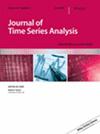Corrigendum to the article “Regular multidimensional stationary time series”
IF 1.2
4区 数学
Q3 MATHEMATICS, INTERDISCIPLINARY APPLICATIONS
引用次数: 0
Abstract
In Theorem 2.1 which was the main result of the article it was implicitly assumed that for any regular -dimensional weakly stationary time series of rank , , there exists an analytic spectral factor of the form , where is the diagonal matrix of the positive eigenvalues of the spectral density matrix and is the sub-unitary matrix of the corresponding eigenvectors. In fact, to the best of my knowledge, it is not known if this assumption is true or false.
“正则多维平稳时间序列”一文的勘误表
定理2.1是本文的主要结果,它隐含地假设,对于秩为r,1≤r≤d的任何正则d维弱平稳时间序列{Xt},存在形式为Φ(e−iω)=2πU~(ω)∧r1/2(ω)的解析谱因子Φ(z),其中∧r(ω)是谱密度矩阵f(ω)的正特征值的r×r对角矩阵,U~(ω)为相应特征向量的d×r次酉矩阵。事实上,据我所知,还不知道这个假设是真是假。
本文章由计算机程序翻译,如有差异,请以英文原文为准。
求助全文
约1分钟内获得全文
求助全文
来源期刊

Journal of Time Series Analysis
数学-数学跨学科应用
CiteScore
2.00
自引率
0.00%
发文量
39
审稿时长
6-12 weeks
期刊介绍:
During the last 30 years Time Series Analysis has become one of the most important and widely used branches of Mathematical Statistics. Its fields of application range from neurophysiology to astrophysics and it covers such well-known areas as economic forecasting, study of biological data, control systems, signal processing and communications and vibrations engineering.
The Journal of Time Series Analysis started in 1980, has since become the leading journal in its field, publishing papers on both fundamental theory and applications, as well as review papers dealing with recent advances in major areas of the subject and short communications on theoretical developments. The editorial board consists of many of the world''s leading experts in Time Series Analysis.
 求助内容:
求助内容: 应助结果提醒方式:
应助结果提醒方式:


